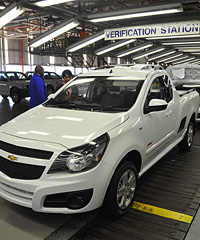Why General Motors consolidated its African divisions
General Motors (GM), with brands such as Chevrolet, Isuzu and Opel, has recently consolidated its African divisions into one Africa unit. The company, which does business in more than 50 markets in Africa, sold 180,493 vehicles on the continent last year, an increase of 17.5% from the previous year.

GM has manufacturing operations in South Africa, Egypt and Kenya.
Mario Spangenberg, who had headed the GM North Africa division, has recently taken up the new position of president and managing director of GM Africa. How we made it in Africa asks Spangenberg about the decision to consolidate the company’s Africa divisions and their plans for 2013.
What is the reasoning behind consolidating your African divisions into one Africa unit?
This consolidation will put General Motors in a strong position to expand on a continent which has tremendous long-term potential for vehicle sales growth. As Africa’s workforce grows and rates of urbanisation increase, this will spur on additional infrastructural investment and will result in increased consumer spending.
We do business in more than 50 markets in Africa, and have manufacturing operations in South Africa, Egypt and Kenya.
In the past, How we made it in Africa has interviewed many companies that have stressed that Africa is a huge and diverse continent and unique strategies are therefore required for different regions and countries. Won’t this consolidation of GM’s divisions undermine the company’s ability to offer unique solutions to each of these markets?
While it is true that there are significant differences in Africa, there are also significant similarities within certain countries. We work with distribution partners who operate across the continent and together this enables us to focus both on the unique requirements for each market as well as the areas of synergy.
Which countries are leading in terms of GM sales and why do you think that is?
In 2012 we sold 180,493 vehicles in Africa, an increase of 17.5% from the previous year. Just over 100,000 vehicles were sold in North Africa and the balance in sub-Saharan Africa. In North Africa, Egypt is our highest volume market while other key markets include Algeria, Morocco and Libya. South Africa is our biggest market in sub-Saharan Africa and high potential markets include Angola, Nigeria, Kenya, Ghana, Senegal, Ethiopia, Zimbabwe and Mozambique.
In East Africa, where our Isuzu brand is strong, our market share grew from 25% in 2011 to 27% last year, ensuring our number one position in this market.
Describe some of the vehicle sales trends that you have witnessed in Africa over the past few years.
Interestingly our vehicle sales levels peaked at their highest levels in 2008. This happened in the year of the global economic crisis which had a delayed impact on the African continent with sales levels here only decreasing in 2009. It also took Africa longer to recover from the economic downturn and it was only in 2012 that growth levels achieved double digit levels again and, in our case, grew by a very healthy 17.5% versus 2011.
Light commercial vehicles, trucks and buses continue to be key segments in the African market and as infrastructure continues to develop, there is a growing requirement to transport people and goods.
What challenges does GM generally face in its business in Africa?
Uncontrolled grey/used vehicle imports constitute between 70-90% of the total vehicle sales industry in many African markets, making it very difficult to convince consumers of the benefits of purchasing new vehicles versus these vehicles. This increases the risk of consumers owning vehicles, which are inappropriate for operating conditions in the specific market and not having access to the right parts and service support.
To address this we are making significant investments in providing strong after sales support to our customers in Africa. We have invested US$30 million in establishing a Parts Distribution Centre in South Africa and also make use of a hi-tech parts facility in Dubai to ensure that our distributors and customers across the continent get the most effective parts support.
Additionally we are rolling out technical training programmes to ensure that together with our distributors we are able to provide outstanding levels of service and support to our customers.
What are GM’s plans and goals for Africa in 2013?
Our primary objective is to grow and expand our presence in Africa through our great portfolio of Chevrolet, Isuzu and Opel products which cover a range of passenger vehicles, light commercial vehicles, trucks and buses.
Furthermore our manufacturing facilities in South Africa and Egypt are geared up to provide the latest generation of light commercial vehicles to our customers in Africa.

